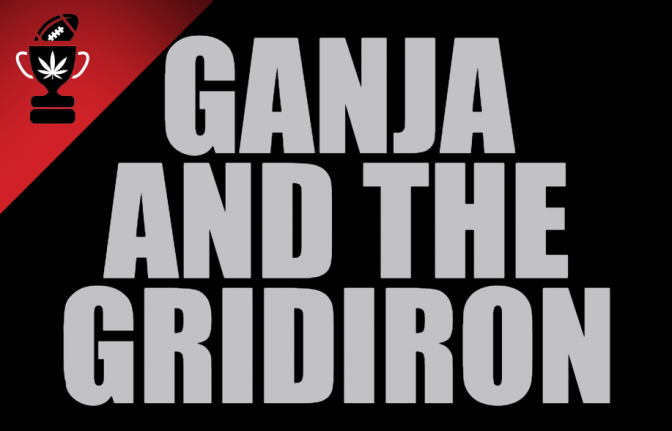Freedom Leaf Special Report: Ganja and the Gridiron

Until recently, Eugene Monroe was an offensive tackle for the NFL’s Baltimore Ravens. Linemen like him protect the quarterback and block for runners; they’re guaranteed to be hit on nearly every play in the gridiron, and they get the least fanfare of any position played. Normally, you’d never see Eugene Monroe in the headlines.
But Monroe is an activist who’s called for the NFL to allow the use of medical marijuana by its players. In March, he tweeted: “Let’s research how cannabinoids may help curb traumatic brain injury. Smoking weed just may protect your brain.”
A 2009 first-round pick out of the University of Virginia, who played for the Jacksonville Jaguars until a trade sent him to Baltimore in 2013, Monroe contributed $80,000 to CW Hemp and Realm of Caring in Colorado for medical marijuana research, and continued to speak out for more tolerance from the league. In June, the Ravens cut him from the team.
Six weeks later, on July 22, Monroe announced his retirement from the NFL after just seven seasons, writing on The Players’ Tribune website: “The last 18 years have been full of traumatic injuries to both my head and body. I’m not complaining, just stating a fact. Has the damage to my brain already been done? Do I have CTE? I hope I don’t. But over 90% of the brains of former NFL players that have been examined showed signs of the disease. I’m terrified.”
Despite 20 of its 32 teams playing in states where medical marijuana is now legal, the NFL still categorizes cannabis as a banned substance. But players like Monroe are fighting back and demanding that the NFL end its restriction on medical cannabis. Evidence of marijuana’s efficacy in treating head trauma and chronic pain is persuasive. Players are increasingly aware of the long-term health effects of opioid painkillers, and want a safer herbal option.
 Getting Your Bell Rung
Getting Your Bell Rung
Jim McMahon was the “punky QB” who led the 1985 Chicago Bears to victory in Super Bowl XX. Players smoked pot back then, but weren’t as informed about its medical benefits as they are now.
At the Southwest Cannabis Conference in Fort Worth, Tx. in February, McMahon told Freedom Leaf: “[Coaches] used to just yell at us, ‘You’re a bunch of pot smokers. That’s why you need water.’”
McMahon has joined the Gridiron Cannabis Coalition (GCC), which consists of players, coaches, doctors and others seeking to educate the NFL about medical cannabis. (See Freedom Leaf’s interview with GCC founder Kyle Turley.)
“It definitely helps, for me,” McMahon added. “I get shooting pains. I’ll go weeks at a time not getting out of bed, and that’s when I know I’ve got to go back and see the doc.”
McMahon suffers from a number of chronic pain conditions due to years of punishing hits. Chief among them is head and neck pain as a result of numerous concussions, or as McMahon puts it, “getting your bell rung”—a euphemism used by football coaches at every level across the country for potentially severe head trauma.
Chronic Traumatic Encephalopathy
When your brain smashes against your skull, it causes tearing and shearing of tissues. The condition is known as chronic traumatic encephalopathy, or CTE. It’s a disease that can only be diagnosed via autopsy, and was first discovered by Dr. Bennet Omalu in 2002. Will Smith played Dr. Omalu in the 2015 movie Concussion, which portrayed the ongoing battle to get the NFL to address the issue.
CTE sufferers experience terrible pain, depression, suicidal thoughts and psychotic breaks. Omalu initially found CTE in the brain of Pittsburgh Steelers’ Hall of Fame center Mike Webster, who battled bouts of rage and depression, and died at age 50 in 2002. Ten years later, CTE was discovered in the brain of Jovan Belcher, a linebacker for the Kansas City Chiefs, who murdered his girlfriend and shot himself in front of his coaches and teammates. CTE also claimed Hall of Fame linebacker Junior Seau, who committed suicide in 2012. Seau shot himself in the chest, like Chicago Bears safety Dave Duerson did the year before; Duerson left a note asking that his brain be autopsied, and CTE was found.
At this point, more than 90 deceased NFL players are known to have suffered from CTE. How concussions proceed into full-blown CTE is not yet well understood. What’s beginning to be realized, however, is that use of medical cannabis may be one of the best preventive measures against the effects of concussions.
Concussions and Cannabis
Following a concussion, the post-concussion syndrome includes headaches, dizziness, irritability, insomnia, memory problems and sensitivity to noise and light. The symptoms develop within the first week following a concussion, and can last three months to a year, or longer.
Recent research has shown that cannabidiol (CBD), one of the non-psychoactive cannabinoids in marijuana, provides a neuroprotective effect against brain damage from concussions. Use of CBD has also been shown to reduce brain swelling and inflammation after concussions.
But as the research continues to validate what many players know from their own experiences, the NFL refuses to budge on its anti-marijuana stance. In February, Commissioner Roger Goodell told reporters, “It’s an NFL policy—and we believe it’s the correct policy for now—in the best interest of our players and the long-term health of our players.”
When pressed about players like McMahon speaking out for medical cannabis, and the recent advances in research on cannabis and concussions, Goodell demurred: “I don’t distinguish between the medical marijuana and marijuana issue in the context of my previous answer…. Yes, I agree there [have] been changes, but not significant enough changes that our medical personnel have changed their view.”
Former New York Jets defensive end Marvin Washington disagrees with the commissioner. “Roger Goodell says, ‘We’re following the science,’” he tells Freedom Leaf. “They need to research this. They need to lead the science.”
Washington is a victim of the NFL drug policy that favors painkillers like Naprosyn, Oxycontin and Percocet over marijuana. He now prefers “something that’s natural, that has no negative side effects and no addiction problems.”
In 2013, the NFL settled a multimillion-dollar lawsuit by more than 4,800 former players over the issue of concussions; the players claimed the league had failed to inform them of the true dangers involved. However, the settlement (approximately $190,000 per player) was considered insufficient. (The value of the league’s 32 teams combined is $63 billion.)
Painkillers vs. Pot
Even if an NFL player avoids a concussion, there are myriad ways for him to suffer pain. For NFL teams, keeping players on the field and off the disabled list is paramount. Team doctors know this, and frequently supply their players with powerful and addictive opioids to address their injuries.
Back in 1996, legendary former Green Bay Packers quarterback Brett Favre became one of the first NFL players to publicly admit to having a problem with painkillers. In 2014, former linebacker Scott Fujita told the Washington Post that team doctors gave him “the craziest big pill bottle you’ve ever seen” filled with at least 125 Percocets. Former offensive lineman Rex Hadnot explained how he received injections of Toradol, a powerful anti-inflammatory, once a week for nine years; the FDA recommends using Toradol for no more than five days due to risk of kidney damage.
In 2015, 1,500 former players filed a class-action lawsuit against the NFL that claims, “… teams and their training staffs dispensed powerful drugs while misleading them about the health risks,” and that NFL team doctors “were routinely and indiscriminately [giving out] powerful painkillers, often without prescriptions or even a cursory exam, to mask pain and injuries and get [players] back on the field without regard for their long-term health.” The suit is ongoing, and survived an initial motion to dismiss by the NFL.
The No Fun League
The NFL keeps marijuana on its banned substances list not because it’s a performance-enhancing drug, but because it’s still federally illegal. The league markets heavily to young people, and doesn’t want to be portrayed as soft on drugs. It’s also no coincidence that the biggest advertisers on NFL telecasts include beer and pharmaceutical companies that face direct competition from marijuana.
For many years, the league maintained one of the strictest limits for drug testing for marijuana among its players: Just 15 nanograms (ng) of marijuana metabolite in a urine sample was enough to fail the test. In 2014, the league upped the limit to 35 ng; in comparison, Major League Baseball requires 50 ng for a failed test.
In 2013, the World Anti-Doping Agency, which tests Olympic athletes, raised its threshold from 15 to 150 ng, arguing that it would help prevent catching athletes who weren’t actually high during competition. The same year, the Nevada State Athletic Commission, which sanctions many professional boxing matches, raised their standard from 50 to 150 ng, as well. Only the NBA and NCAA maintain stricter policies: The NBA’s threshold is 15 ng, and the NCAA lowered its threshold from 15 ng to just five ng in 2014. The National Hockey League is the only major sports organization that doesn’t test for marijuana metabolites.
Failing an NFL drug test has serious consequences for a player. This year the annual testing began on Apr. 20 and continued through Aug. 9. Once a player passes that one annual test, he’s unlikely to be tested again until the following year, unless he raises a red flag through a marijuana arrest or public incident. Even joking on Twitter about the 4/20 holiday can earn a player a “random” request from the NFL for a drug test sample, as Indianapolis Colts punter Pat McAfee learned the day after he tweeted, “I can’t celebrate this particular day. But I know a large % of my followers are.”
 The NFL’s substance abuse policy, agreed to by the NFL Players Association and in effect until 2021, specifies a series of increasing penalties for marijuana test failures, beginning with a mandatory substance abuse program for first-time offenders. Subsequent offenses earn suspensions and loss of pay, as was the case with Denver Broncos Super Bowl 50 MVP linebacker Von Miller, who sat out six games in 2013. Repeat offenders like Cleveland Browns All-Pro receiver Josh Gordon have received season-long bans.
The NFL’s substance abuse policy, agreed to by the NFL Players Association and in effect until 2021, specifies a series of increasing penalties for marijuana test failures, beginning with a mandatory substance abuse program for first-time offenders. Subsequent offenses earn suspensions and loss of pay, as was the case with Denver Broncos Super Bowl 50 MVP linebacker Von Miller, who sat out six games in 2013. Repeat offenders like Cleveland Browns All-Pro receiver Josh Gordon have received season-long bans.
The NFL’s policy also harms the careers of college athletes. University of Mississippi offensive tackle Laremy Tunsil was projected to be the No. 1 pick in the 2016 draft until a video of him using a gas mask bong was posted on Twitter. Tunsil’s draft position plummeted to No. 13, and in May he signed a significantly reduced four-year, $12.5 million contract with the Miami Dolphins.
With nine states voting on adult-use legalization or medical marijuana in November, the NFL could find itself with three-quarters of its teams playing in medical marijuana states and one-quarter playing in legal marijuana states; the country could have 30 medical marijuana states and nine adult-legalization states by the time the next Super Bowl is played next February. It’s high time for the NFL to adopt a sensible policy on cannabis use by its players.
If you enjoyed this Freedom Leaf article, consider subscribing today!


